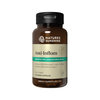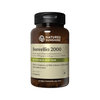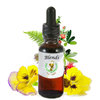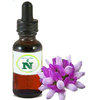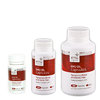Please note that, according to our professional standards of care, we must ensure that our practitioners' only products are safe and suitable for the intended outcome. Therefore we require the submission of a Risk Assesment Form (access HERE ) prior to the supply of herbal extracts. If you are unable or unwilling to reveal personal information, please contact the pharmacy for a chat with a practitioner and an alternative solution.
Fluid extract of the root of Turmeric Root 1:1, Curcuma longa, in ethanol and purified water. Common Name: Turmeric
Botanical Name: Curcuma longa
Part Used: Rhizome
Ratio: 1:1
Percentage of alcohol: 69%
Source: Trade
History and Traditional Use
The genus name Curcuma is the Latinized form of the Arabic al-kurkum, which originally meant saffron but now refers exclusively to turmeric. The common name, turmeric, comes from the French terra-mérite (Latin terra merita), meaning meritorious earth—probably because ground turmeric resembles the earth pigment ochre, and perhaps because of the regard in which turmeric was held by ancient peoples. In many languages, the name for turmeric means yellow root, and it is known as Indian saffron in many European languages, although it is a cheap and unacceptable substitute for true saffron (Crocus sativus, Iridaceae).6,7 Known as the “golden spice” or the “spice of life,” turmeric has been held sacred and used medicinally in India for 4000 – 6000 years.2,6 During India’s Vedic period (ca. 1500 – 600 BCE), the orange-yellow rhizome of turmeric was called the “herb of the sun” and was regarded as the most outstanding healing herb.2
Turmeric is widely used in the Indian systems of medicine (Ayurveda, Siddha, and Unani) as well as in Eastern Asian systems (Traditional Chinese Medicine [TCM], Japanese Kampo, Korean, and Malay). In the Ayurvedic system, depending on what it is combined with, turmeric’s main therapeutic uses are for treating disorders due to poison, ulcers, skin diseases and urticaria, urinary disorders, anemia, and chronic rhinitis/sinusitis.8 It is also used in Ayurveda for anorexia, cough, diabetic wounds, biliary and liver disorders, and rheumatism.2 Many Ayurvedic healers integrate the powder into a paste or lotion for the treatment of dry and flaking skin, skin sores and wounds, external inflammations, and painful arthritis.1,2,9 In the Unani system, turmeric is used therapeutically to treat ulcers, rheumatoid arthritis, conjunctivitis, eye strain, hiccough, asthma, catarrh, and itching.10
Traditional use as herbal medicine has shown Turmeric extract to be efficient in alleviating pain and inflammation in arthritis and related joint conditions.
Traditional medicinal practices in India and China used the benefits of this bitter-tasting and slightly fragrant root as a digestive aid.11 In TCM, turmeric is specifically indicated for treatment of amenorrhea (absence of menstrual periods), mass formation in the abdomen, rheumatic pain of the shoulders and arms, traumatic swelling and pain, and pricking pain in the chest and abdominal regions.12
Turmeric is incorporated into teas and is a base component in many culinary spice blends, specifically curry.1,3,6 It is a component in kedgeree and piccalilli (England), sofrito (Africa), and la-kama (Morocco).13 The fresh rhizome is preferred in Thailand, where it is grated and added to curry dishes and yellow curry paste.6 Yellow rice, made by the addition of fresh or dried turmeric, is a dietary staple on the Eastern islands of Indonesia; in Bali, yellow rice is used as an offering to the Hindu deities. Turmeric has also become a staple in Ethiopian cuisine.5,13 Turmeric essential oil is used to improve the taste of stomach bitters, and the oleoresin is used in the food industry in sauces, soups, and instant meals.13 Because of its brilliant color, turmeric has also been traditionally employed as a dye to color not only foods but cosmetics, paper, wood, and fabrics, specifically the golden robes worn by Thai Buddhist monks.9
Hundreds of Evidence based studies have shown that the roots of Turmeric contain active compounds, such as curcumin, with significant anti-inflammatory and anti-oxidant activity, amongst others, which may be of benefit to our health in a number of conditions where inflammation is present, in anti-ageing and preventative medicine.
Contraindications: Obstruction of bile passages. In case of gallstones, use only after consulting with a physician
References: For complete list of references, please click here.
Disclaimer: The above information is for educational purposes only and not part of therapeutic claim for any particular product.




